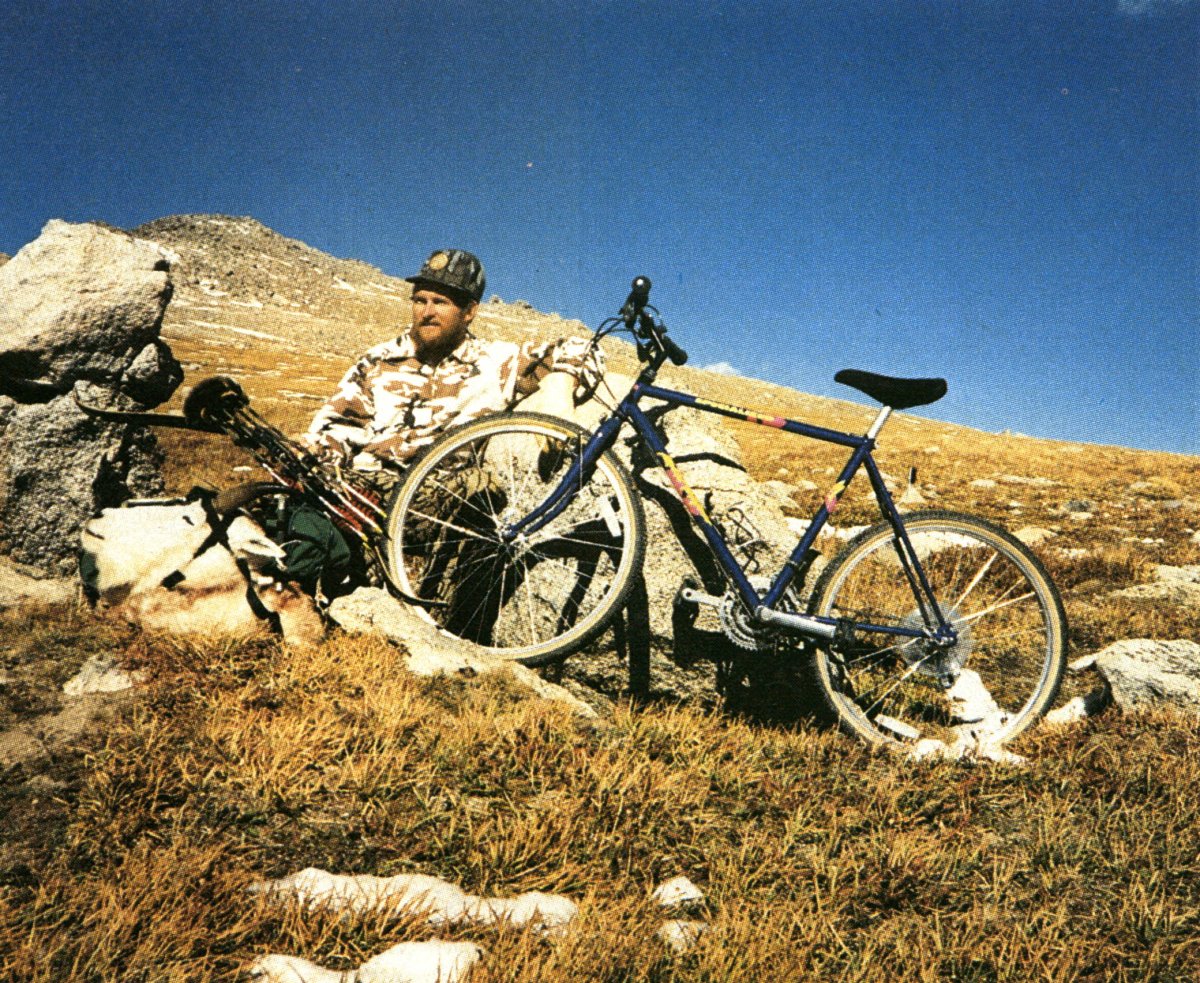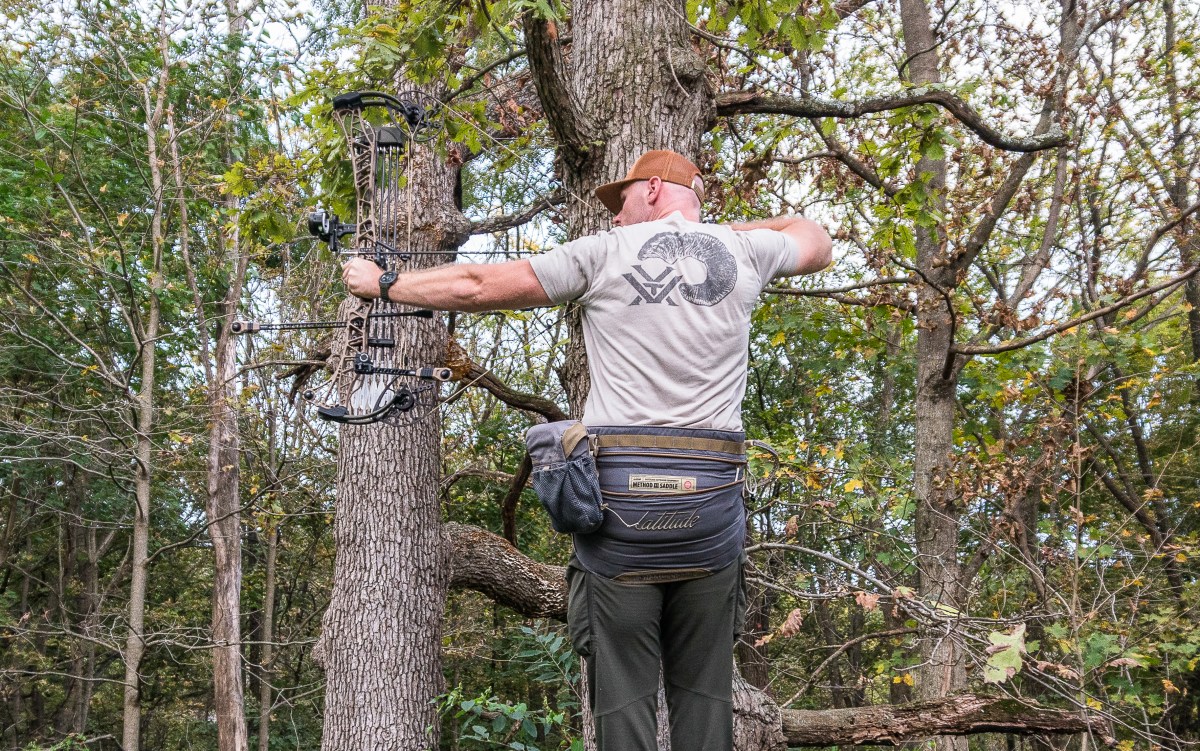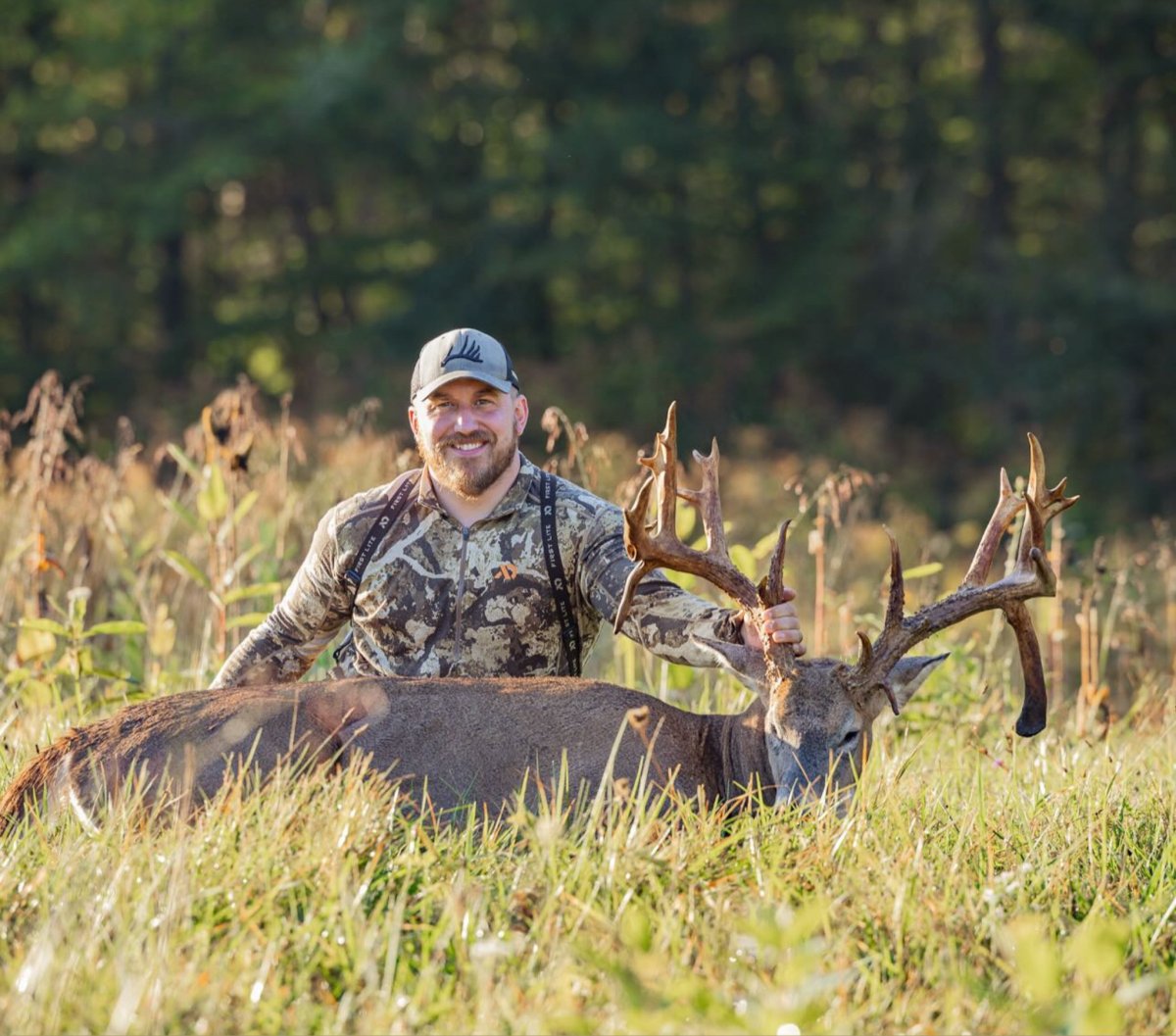Best Tree Stand Harnesses of 2025
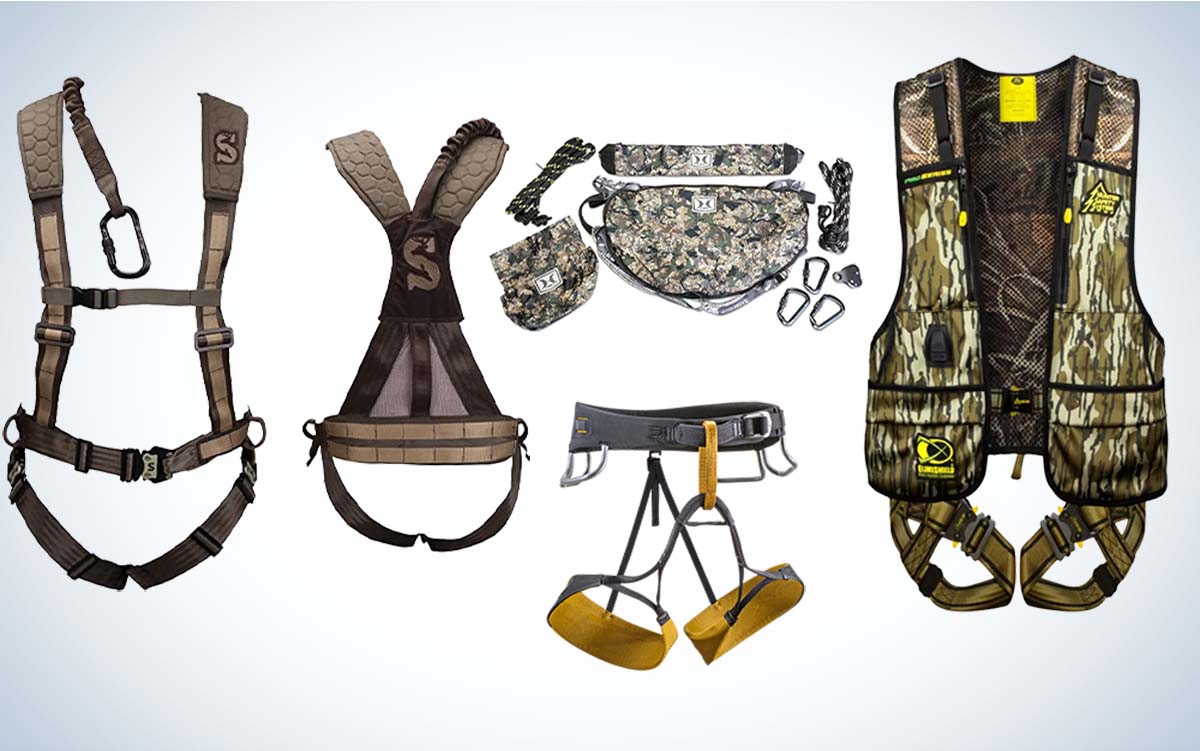
We may earn revenue from the products available on this page and participate in affiliate programs. Learn More ›
With plenty of collective experience hunting from tree stands, we’ve been around long enough to remember when hunter safety classes focused mainly on firearm safety. In those days, tree stand safety was treated as more of an afterthought than a priority. Today, tree stand hunters are more likely to wear a harness while hunting, and with the increase in demand, the industry has answered with top notch harnesses that prioritize comfort as much as safety. We spent plenty of time climbing and sitting in trees to bring you the best tree stand harnesses on the market today. Here’s what we found.
How We Tested the Best Tree Stand Harnesses
Because safety testing for tree stand harnesses is a rigorous process conducted by certified third-party labs, it would be silly and superfluous for us to try to replicate fall scenarios. All the harnesses on this list have already met or exceeded the safety requirements set by the Treestand Manufacturers’ Association (TMA), which adheres to stringent international standards to ensure harnesses provide the high level of protection hunters need when hunting from elevated positions.
Instead, we focused our hands-on testing on the aspects that matter most in the field—comfort, mobility, and ease of use. Our testers wore each harness over a range of typical hunting layers and evaluated fit and comfort. We also tested how easy it was to move, draw, and shoot a bow while wearing each harness, which is really where the rubber meets the road in real-world hunting situations. Our goal was to highlight the models that not only meet safety standards but also work well in the field.
Best Tree Stand Harnesses: Reviews and Recommendations
Best Overall: Hunter’s Safety System Pro Series
See It
Pros
- Eight pockets are extremely handy
- Putting on/taking off the vest is easy
Cons
- Complex lineman’s belt procedure
- Self-rescue might be more challenging than other options on this list
Key Features
-
Eight Pockets including two zippered chest pockets -
Weight:
Just under 4 pounds -
Includes two sets of instructions and instructional DVD -
Recommended Lifespan:
Five years -
Weight Limit:
300 pounds
This vest, like others of its type, has a harness tether attached to the middle of the back at the collar area. The tether with sewn-in shock absorption stays out of your way while hunting but can result in suspension facing away from the tree after an arrested fall. This orientation plus the length of the harness tether, especially if the shock absorbing stitching deploys, plus the major upward shift of everything in suspension, means you’ll be hanging far below your anchor point on the tree.
The lineman’s climbing belt seems very secure and is the only one I have seen that encircles the hunter’s entire body. However, the instructions for the lineman’s belt took me a while to interpret. But you’ll want to attach the tree tether whenever using the lineman’s belt to be doubly connected. This double-connection to the tree is vital for all harnesses if climbing past a limb or tree stand.
Hanging in this harness was uncomfortable, chiefly around the legs and crotch. And you’ll definitely want to wear this harness to the stand, as it doesn’t come with a carry pouch, and it would be a bit bulky to stuff in a pack. The long harness tether is a snag hazard and should be tucked inside the vest during travel—especially on an atv. But for tree stand hunters that want a full body harness with a snug fit and plenty of storage for your gear, the Hunter’s Safety System Pro Series is a great option.
Best Budget: Muddy Magnum Elite Harness
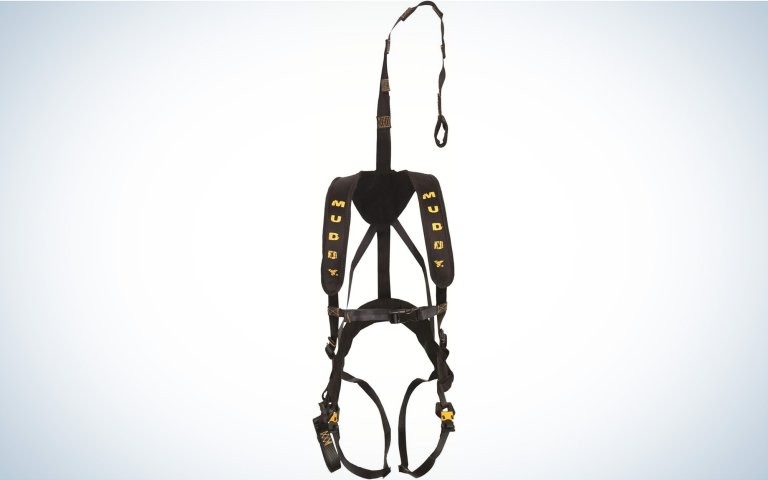
See It
Pros
- Affordable
- Lightweight
- Includes lineman’s belt
Cons
- Adjustments are tricky
- Doesn’t fit very small bodies
Key Features
-
Sizes:
One size fits most -
Weight:
1.5 pounds -
Weight Limit:
300 pounds
For hunters who want reliable safety at a budget-friendly price point, the Magnum Elite delivers. This one checks all the essential boxes — TMA-certified safety, included lineman’s belt, and quick-release buckles — without draining your gear budget. It’s a bit fiddly to put on and took some effort to get adjusted correctly, but the good news is you won’t need to tweak the fit every time you put it on.
Muddy labels this as a “one size fits most” harness, and while it works for plenty of my hunting buddies, it’s not ideal for users like me with small frames. I had to cinch every strap to its limit to get it to fit. It’ll work fine for cold-weather hunts when I’m layered up, but if I drop a few pounds, I’ll need to trade this one in for a different harness.
Most Comfortable: Summit Pro Safety Harness

See It
Pros
- Simple, easy to use
- Small footprint
- Includes lineman’s belt
Cons
- The suspension-relief strap is difficult to return to its pouch
- For climbing into fixed stands, you’ll need a second rope to be tied in at all times
Key Features
-
Weight:
4.5 pounds with just one tree strap -
Weight Limit:
300 pounds -
Recommended Lifespan:
Five years (three years for the safety/lineman’s rope) -
Size:
28-35-inch waist (men’s)
The Pro Summit Safety Harness is comfortable enough to wear on your hike to the stand, and the tied loop on the safety/lineman’s rope is large enough to pass the carabiner and prussic through without detaching it. This extremely adjustable harness includes a stretchy chest strap that reduces the chances of strangulation if you sink too low in the harness while suspended. Because it’s so adjustable, this harness is plenty comfortable to wear on your trek to the stand and for those all-day sits. There are no pouches included, so the tree tether/lineman’s climbing strap must be carried separately.
The tree tether has an energy-absorbing section as well as sewn-in tear-outs. But the design of the harness made it hard for me to reach the vest tree tether without removing the shoulder straps. It does include a suspension-relief strap in a handy storage pouch that’s connected to the harness, which is fastened at one end and then deployed and attached to the lineman’s belt loop.
When you tie-off the strap, try a slip knot, as I needed two tries to get the loop length correct. It took some wiggling to stand up in the suspension-relief strap, so practice several times near the ground before hunting with it. Still, the Summit Pro is one of the more comfortable harnesses from my test, and is a great option if you’ve got a long walk and an all day sit planned for your next hunt.
Best Features: Hawk Elevate Pro Harness
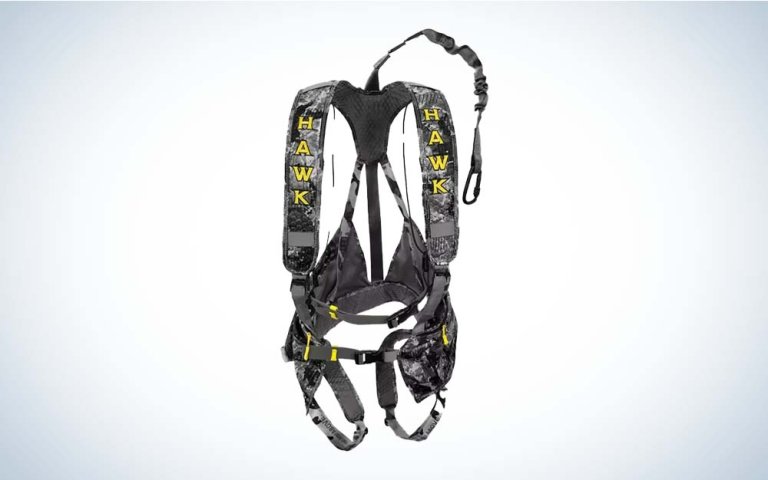
See It
Pros
- Super easy to put on/take off
- Padded leg straps are an excellent touch
- Convenient pockets
Cons
- Might not fit smaller hunters super well
Key Features
-
Weight:
3.7 pounds with tree and climbing belt -
Recommended Lifespan:
Five years -
Weight Limit:
300 pounds -
Quick-release leg buckles
The Hawk Elevate Pro Harness has tons of thoughtful features that make it comfortable and convenient to use. This “one-size-fits-most” harness was a little too big on my 5-foot 8-inch, 140-pound body. So a smaller size would benefit smaller stature hunters. While it doesn’t seem like a big deal, the size of the harness resulted in some of my weight being suspended at my armpits rather than evenly distributed. You can mitigate the size problem with more clothes, but there are plenty of single layer hunting days during the early season.
The tree tether has a shock-absorbing section as well as tear-out pleats. I was able to reach the tether while wearing the vest, and the harness comes with both a tree belt and a climbing rope with a prusik knot. The looped end of the climbing rope was big enough to slide the prusik and carabiner through. In general, this harness was impressive in the consideration of practical aspects of use. For example the tree belt has a sewn-in attachment loop for connecting the carabiner.
When you tie it off, use a slip knot to aid in getting the loop length correct. The shorter climbing rope means it is easier to handle with less excess flopping around. However, it would not be long enough for large-diameter trees. The harness adjustment belts have clips built in for housing the tag ends so they don’t flop around. Even the loops for attaching the climbing belt have elastic holders to keep the loops out of the way. There are so many subtle but thoughtful details in the Hawk Elevate Pro that make it one of the best harnesses not just to wear.
Best for Small Bodies: Muddy Safeguard Harness
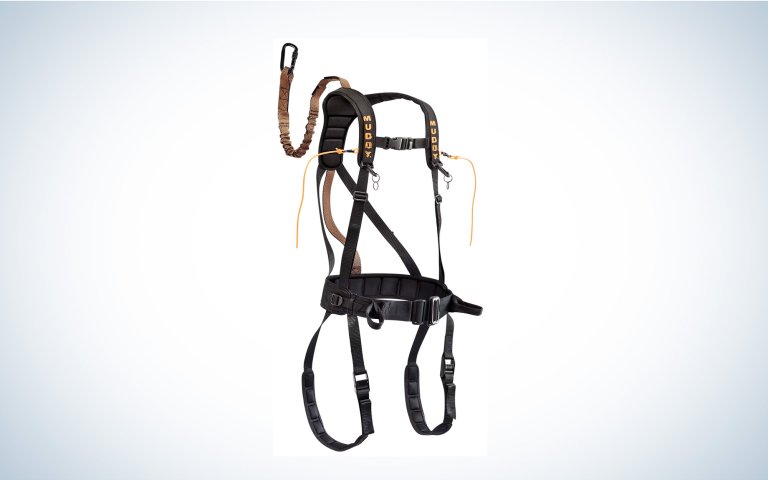
See It
Pros
- Integrated bino straps and gear lanyards
- Easy to adjust
- Lightweight
Key Features
-
Sizes:
S/M, L, XL, and Youth -
Weight:
1.5 pounds -
Weight Limit:
S/M- 250 pounds; L/XL – 300 pounds; Youth – 150 pounds
The Muddy Safeguard is super light and sized to fit virtually every body type. Minimal fabric and thoughtful features make this harness a great choice for early-season use. It won’t trap heat, interfere with movement, or get bulky when it’s time to add layers.
One of the standout features is the bungee-like tether, which allows for 360-degree movement around the tree. You also get two gear lanyards for keeping calls and rangefinders handy and built-in bino straps, so there’s no need to wear an extra harness.
The strap system adjusts easily, and sizing options make this harness accessible for youth and smaller hunters. My only gripe is the extra strap material that flaps around if you don’t take the time to figure out where to tuck it.
Things to Consider Before Buying a Tree Stand Harness
While a tree stand harness might seem like an afterthought compared to your other gear, it shouldn’t. Whether you’re hauling a ton of gear into a deep piece of public or doing a quick hunt behind the house after work, you should treat your tree stand harness just as vital as the weapon you’re hunting with.
The most popular harnesses currently available are full-body harnesses and vests specifically designed for tree stand hunting. This contractor-style full-body harness is the only type currently approved by the Tree Stand Manufacturers’ Association.
I have worn a lot of different types of hunting safety harnesses. All of them can help protect against tree stand falls, which is their primary function, but some are more practical than others. Here are three main factors to consider when purchasing one.
Ease of Use
The most important feature of a harness is ease of use. I say this because scientific survey research shows that many hunters, even hunter safety instructors, fail to wear a harness simply because they are difficult to use. The harder it is to use, the less likely hunters are to wear it. While this isn’t a good reason not to wear a harness, unfortunately, it’s a reality for a lot of hunters. Ease of use encompasses overall weight, ease of putting on and taking off, comfort during wear and removal, and general convenience.
Recovery After a Fall
The second most important feature is how easy the recovery process is in the event of a fall. If a fall were to occur and the harness did its job of keeping you from hitting the ground, it must either allow you to regain your stand or safely descend. Hanging in most harnesses quickly becomes painful, and in some cases, can cause you to lose consciousness. In extreme cases, it has resulted in death (due to suspension trauma), so an effective harness escape plan is vital. And, this is not always easy.
Comfort
Comfort is another key quality of tree stand harnesses. You are more likely to leave an uncomfortable harness in the truck. If you do decide to wear it, it can detract from the hunt. As the air temperature of the hunt changes, a harness that allows you to put on or take off extra layers can make your hunt way more enjoyable and efficient.
FAQs
Absolutely. If you hunt from any elevated stand that isn’t fully enclosed, then you shouldn’t leave the ground without a tree stand harness anchored securely.
The best harness is the one you will use every time you leave the ground. For different hunters, that will vary. I love simplicity and a harness that I can don at the truck and wear to the stand. Personally, I prefer a harness that allows me to be rest in a sitting position if I fall into it—for comfort and safety from suspension trauma. But you might have different criteria, so list your needs and find a harness that you’ll like and use.
The heaviest harness and the lightest harness I have weighed only differed by about 3.5 pounds. For most of us that is a negligible difference. If you are packing in a lot of gear a long distance, a rock climbing harness will likely be the lightest option. However, once you consider the weight of a portable stand plus your harness, a tree saddle will cut down on your total weight overall and likely be the lightest option.
You should wear a harness and be connected to a safety line from the moment you leave the ground to the moment you return.
Final Thoughts on the Best Treestand Harnesses
The best tree stand harnesses could well save your life or prevent a hunting-ending injury. The key issue is to find a harness design that you will use properly every hunt. Wear it from the ground up and down again and always have it firmly anchored. Inspect your harness before each use and do not exceed the expiration date or weight limit for it. Follow manufacturers’ warnings, and don’t expose harnesses to the weather when not in use. Make sure you can self-rescue from suspension. And above all, be safe.
Read the full article here





